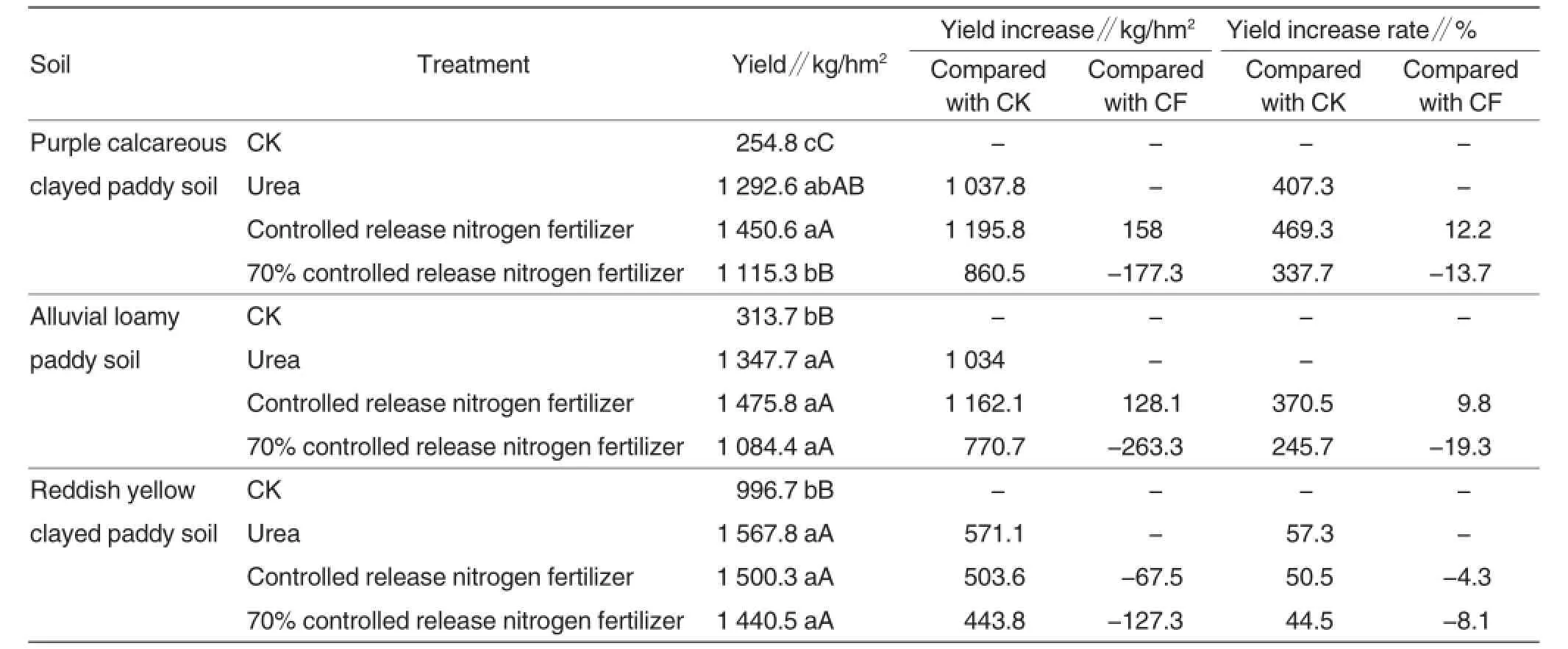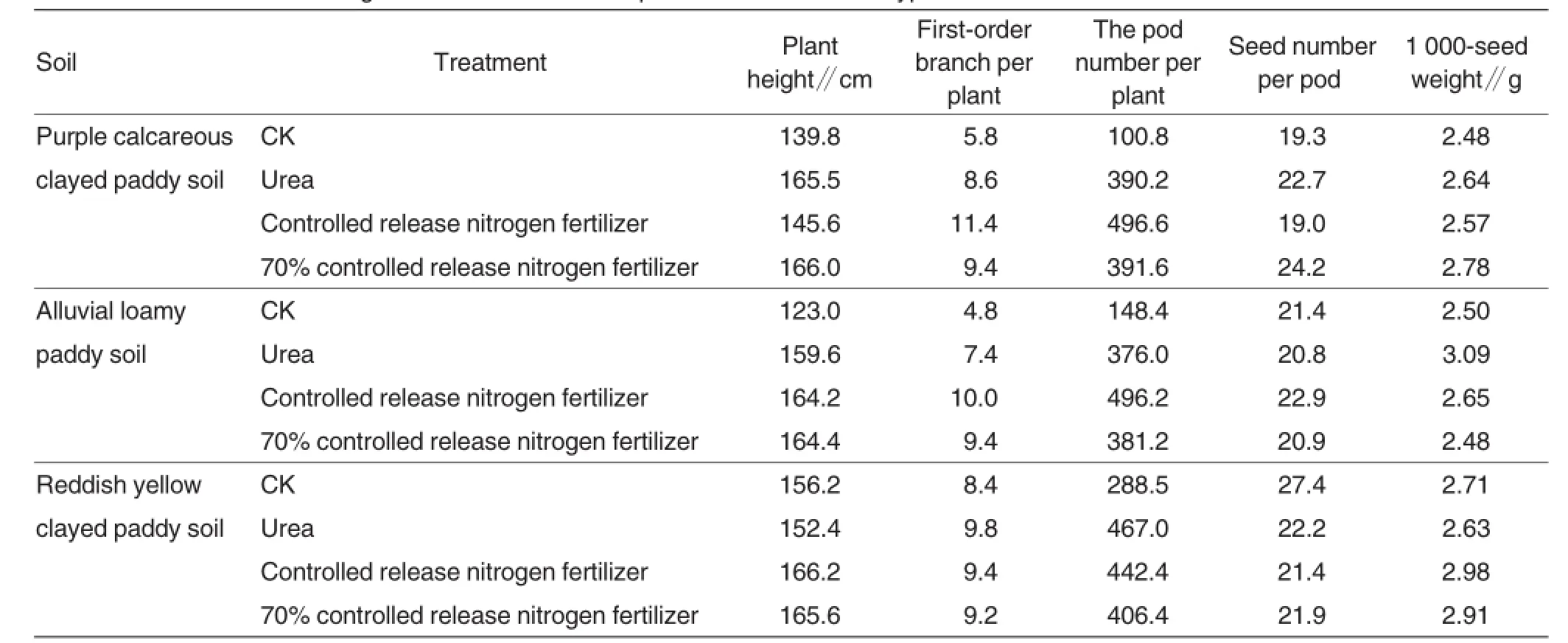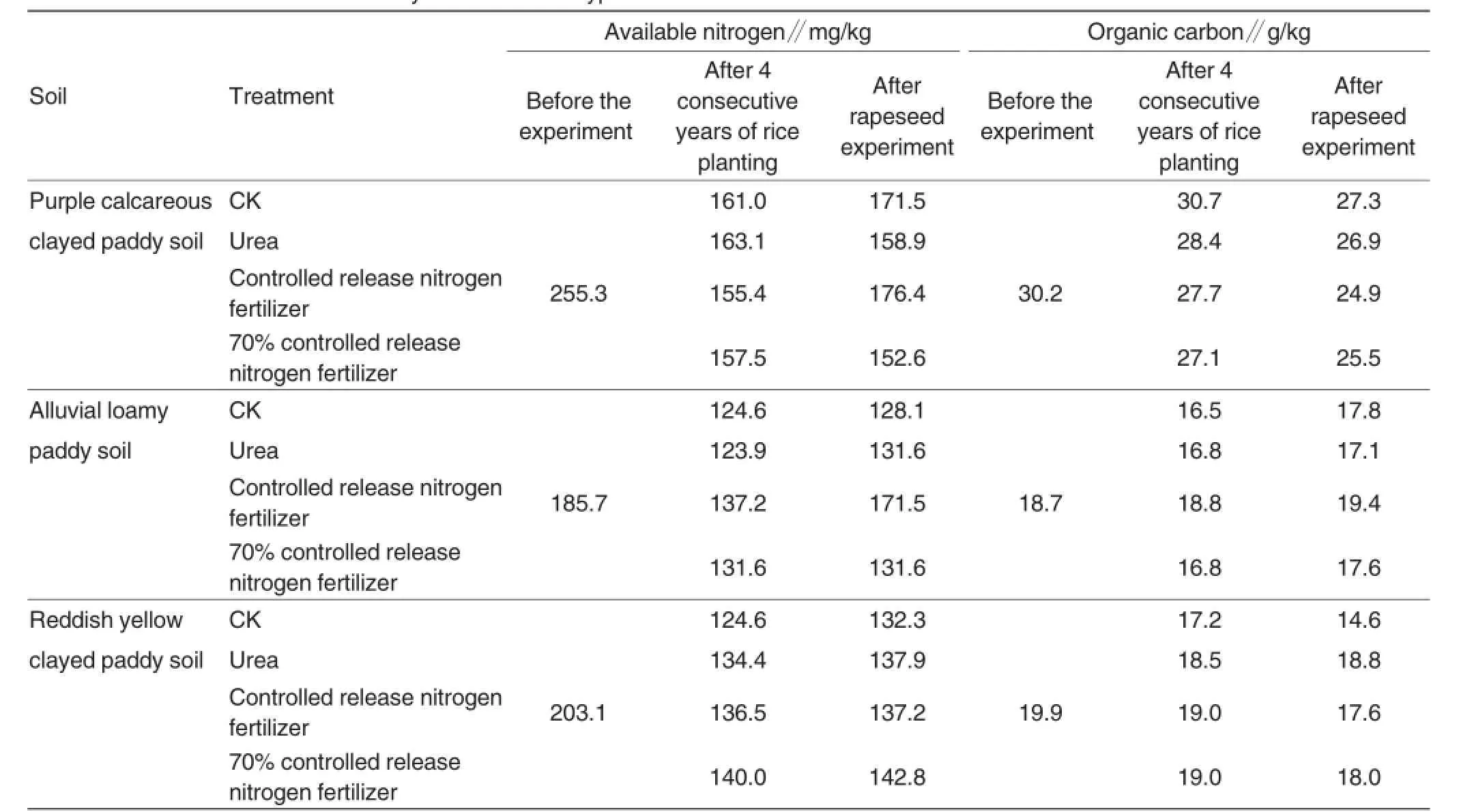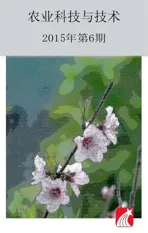Effects of the Application of Controlled Release Nitrogen Fertilizer on Rapeseed Yield,Agronomic Characters and Soil Fertility
2015-02-05YanhongLUYutaoSUNYulinLIAOJunNIEJianXIEZengpingYANGXingZHOU
Yanhong LU,Yutao SUN,Yulin LIAO*,Jun NIE,Jian XIE,Zengping YANG,Xing ZHOU
1.Soil and Fertilizer Institute of Hunan Province,Hunan Academy of Agricultural Sciences,Changsha 410125,China;
2.Scientific Observing and Experimental Station of Arable Land Conservation(Hunan),Ministry of Agriculture of China,Changsha 410125,China;
3.College of Resources and Environment,Hunan Agricultural University,Changsha 410128,China
Effects of the Application of Controlled Release Nitrogen Fertilizer on Rapeseed Yield,Agronomic Characters and Soil Fertility
Yanhong LU1,2,Yutao SUN1,2,Yulin LIAO1,2*,Jun NIE1,2,Jian XIE1,2,Zengping YANG1,2,Xing ZHOU1,3
1.Soil and Fertilizer Institute of Hunan Province,Hunan Academy of Agricultural Sciences,Changsha 410125,China;
2.Scientific Observing and Experimental Station of Arable Land Conservation(Hunan),Ministry of Agriculture of China,Changsha 410125,China;
3.College of Resources and Environment,Hunan Agricultural University,Changsha 410128,China
In order to study the effects of controlled release nitrogen fertilizer(CRNF) application on rapeseed,a simulated experiment was carried out with 3 types of paddy soils in Dongting Lake area for 4 consecutive years of applying CRNF under double rice cropping system after planting rapeseed crop in the fallow season.The effects of CRNF application on rapeseed yield,agronomic characters and soil fertility were studied in this paper.The results showed that CRNF application improved the growth of rapeseed plant and increased rapeseed yield of CRNF treatments in the purple calcareous clayed paddy soil(PCS)and alluvial loamy paddy soil(ALS) which respectively increased by 12.2%and 9.8%compared with applying urea,respectively.The rapeseed yield in 70%CRNF treatment obviously decreased compared with urea treatment.The contents of available N and organic carbon in soil increased by 25.0%and 3.2%in CRNF treatment in the ALS after rapeseed crop, respectively;and available N increased by 13.5%in the PCS.Both rapeseed yield and soil fertility in CRNF treatment and 70%CRNF treatment were lower than those in CK treatment in the reddish yellow clayed paddy soil(RYS).The results also indicated that the functions of CRNF application on rapeseed yield increase and soil nitrogen fertility improvement were very obvious in the PCS and ALS.
Controlled release nitrogen fertilizer;Rapeseed yield;Agronomic characters;Soil fertility
I n China,"oil shortage"is more serious than"food deficit",now about 70%edible oil is depending on import.However,the rapeseed is one of the most important oil crops in our country,therefore,its high-efficient production plays a vital role in guaranteeing edible oil safety in our country[1]. "Double rice—rapeseed"is one of the main cropping systems in Hu’nan Province[2],but there have been unreasonable fertilizer application phenomena in rapeseed production at present, especially the unreasonable application of nitrogenous fertilizer,thereby resulting in the low yield of rapeseed and the decreasing fertility of soil nitrogen,which is bad for the sustainable development of agricultural production[3].
Controlled release nitrogen fertilizer(CRNF),as a new kind of fertilizer, its one-off application can meet the nitrogen supply in the entire growth pe-riod.Hence,the reasonable application of CRNF can improve crop yield and nitrogen use efficiency as well as reduce the pollution of NO3--N and NO2--N to the environment[4],which has become the focus of attention of many scholars in recent years.Currently,the study on the application effect of CRNF on rice has showed that the release rate of nitrogen of CRNF is basically in line with the demand of rice,moreover,the supply of nitrogen is persistent during the whole growing period of rice,thereby improving rice yield[5].Based on the application of CRNF in double cropping rice for two consecutive years,the research indicated that the yields of early rice and late rice were respectively increased by 7.7%and 11.6%under one-off application of CRNF compared with twotime application,moreover,its utilization rate of fertilizer reached 76.3%[6]. By15N tracer technique,it was found that CRNF application greatly improved nitrogen use efficiency mainly through reducing leaching,volatilization and nitrification-denitrification of nitrogen losses[7].Nie Jun et al.[8]discussed the reasons of CRNF for increasing rice yield,and held that CRNF application can effectively regulate photosynthesis and endogenous hormone of rice,thus increasing rice yield.There were many studies on the application effects of CRNF on corn, cotton,wheat and vegetable,etc.[9-12], however,these studies mainly focused on the effects of CRNF application on crop yield and nitrogen use efficiency, and the studies on the changes of soil fertility after applying CRNF were few; at the same time,the main study object of those studies was rice,and they also involved corn,cotton,wheat,etc., but the studies on the application of CRNF on rapeseed were relatively few.Therefore,to study the effects of CRNF application on rapeseed,a simulated experiment was carried out with 3 types of paddy soils in Dongting Lake area for 4 consecutive years of applying CRNF under double rice cropping system after planting rapeseed crop in the fallow season;the effects of CRNF application on rapeseed yield,agronomic characters and soil fertility were studied in this study,aiming to provide theoretical basis for reasonably applying CRNF in rapeseed production in Dongting Lake area of our province.
Materials and Methods
Experimental location and general characters of soils
The experiment was carried out in the net room of Hu’nan Academy of Agricultural Sciences.The experimental soils were purple calcareous clayed paddy soil(PCS),alluvial loamy paddy soil(ALS)and reddish yellow clayed paddy soil(RYS).The main physical and chemical properties of soils before the experiment were in Table 1.
Experimental design
The experiment was based on 4 consecutive years of applying CRNF under double rice cropping system after planting rapeseed crop in the fallow season during 2005-2009.The tested rapeseed variety(combination)was‘Xiangyou 7’,which was transplanted on October 28 of 2009 and harvested on May 4 of 2010.There were four treatments:(1)CK(no fertilization),(2) urea,(3)CRNF,(4)70%CRNF.The experiment was arranged randomly with three repetitions.According to the requirements of treatments,the following fertilizers should be applied for one hectare:N 150 kg,P2O575 kg and K2O 150 kg;CRNF and urea contained the same N content.60%of urea was used as base fertilizer,20%of it was used as overwintering fertilizer and the rest of 20%was used as shooting fertilizer;superphosphate was used as P2O5,potassium chloride was used as K2O,and 100%of them were used as base fertilizer.Base fertilizer was applied into the holes near the plants one day before the transplanting of rapeseed,topdressing was applied using the method of sprinkling with water, and 0.4%borax solution was sprayed at the bolting stage(one hectare needed 7.5 kg fertilizer).The field management of each treatment was the same.
Sample collection and measurement
In the bud stage of rapeseed,the growth traits of plants were surveyed and the plant samples were collected to determine the biomass;in the mature period of rapeseed,the plant samples were collected to determine the agronomic traits;the yield of each plot was measures separately.Before the experiment in 2005,basic soil samples had been gathered to determine general physical and chemical properties;after the harvest of late rice in 2009 and the harvest of rapeseed in 2010,the surface soil of each treatment was collected to determine available nitrogen and organic carbon contents.
Soil pH,nitrogen,phosphorus, potassium,available nitrogen and organic carbon were determined using acidimeter method,kjeldahl method, Olsen method,flame photometer method,alkaline hydrolysis diffusion method and potassium dichromate method,respectively[13].
Data analysis
Microsoft Excel 2003 and DPS 7.5 were used for data processing and analysis.
Results and Analyses
Effects of CRNF on rapeseed yield
As seen in Table 2,the experiment of rapeseed planting after 4 consecutive years of double cropping rice planting showed that the yield of rapeseed under nitrogen application multiplied compared with CK treatment(rapeseed in the RYS was less than double),and followed the sequence of PCS>ALS>RYS.Thereinto,the rapeseed yield after CRNF application in the PCS and ALS respectively increased by 12.2%and 9.8%compared with urea treatment which contained the same N content,however, CRNF application in the RYS had not yield-improving effects.Compared with urea treatment,CRNF application in the three soils all had no yield-increasing effects.These indicated that only CRNF which contained the same N content with urea in the PCS and ALS can show yield-improving effects in this experiment.

Table 1The main physical and chemical properties of the experimental soils
Effects of CRNF on agronomic characters of rapeseed
As shown in Table 3,the sampling investigation results in the mature period of rapeseed showed that rapeseed yield after CRNF application in the PCS and ALS increased about 10%compared with urea treatment which contained the same N content, the reason for this was that the pod number per plant in the two soils after CRNF application was separately more than 27.0%and 32.0%of urea treatment;the pod number per plant in the RYS after urea treatment also had more pods.
The results of correlation analysis indicated that rapeseed yield showed extremely significant positive correlation with the pod number per plant (Table 4),correlation coefficient r values of PCS,ALS and RYS were 0.987 5**,0.964 7**and 0.994 4**, respectively;the correlation coefficient r values between yield and 1 000-seed weight of the three soils were 0.525 0, 0.530 3 and 0.526 3,separately;the correlation coefficient r values between yield and the seed number per pod were smaller.These showed that the pod number per plant in the“three yield components”of rapeseed was the decisive factor for yield increase, and the other two yield components of rapeseed(1 000-seed weight and seed number per pod)were general factors.Therefore,nitrogen application for more pods was of crucial importance.The high yield of rapeseed also related to the number of first-order branch,the more the pod number of PCS and ALS under CRNF treatment, the more the number of first-order branch,because CRNF treatment promoted the growth of rapeseed plants, the number of first-order branch in thetwo soils after CRNF application was respectively more than 32.6%and 35.1%of urea treatment.The yield of rapeseed also showed positive correlation with plant height,the correlation between the yield of rapeseed and plant height in the ALS reached significant level.

Table 2Effects of CRNF on rapeseed yield in different soil types

Table 3Effects of CRNF on agronomic characters of rapeseed in different soil types
Effects of CRNF on plant growth of rapeseed in the middle growth stage
In the middle growth stage of rapeseed(bud stage),the survey results showed that rapeseed under CRNF treatment grew well in the PCS and ALS,however,rapeseed under urea treatment grew well in the RYS (Table 5).Rapeseed under CRNF treatment in the PCS and ALS had higher plant height,longer and wider blade than urea treatment,specifically, compared with urea treatment,plant height,blade length and width of rapeseed in the PCS after CRNF treatment were greater than urea treatment by 13.1%,23.6%and 29.3%,respectively;and these of the ALS were greater than urea treatment by 19.5%,4.2% and 7.3%,respectively;as well as these of the RYS were greater than urea treatment by 9.1%,17.5%and 14.7%,respectively.Compared with urea treatment,the bolt height and bolt base perimeter of rapeseed in the PCS after CRNF treatment were separately increased by 71.9%and 11.9%; and these in the ALS respectively increased by 25.2%and 22.0%.Because of the improvement of plant quality,the biomass was improved; compared with urea treatment,the biomass of rapeseed in the PCS and ALS after CRNF treatment separately increased by 4.5%and 48.7%.The treatment effect of 70%CRNF decreased obviously.However,in the RYS,plant height,blade length,blade width,bolt height,bolt base perimeter and biomass of rapeseed under urea treatment were all higher than these under CRNF treatment.The above results indicated that CRNF application in the PCS and ALS can promote the growth of rapeseed,thereby laying a material base for later growth and high yield of rapeseed.
Effects of CRNF on soil fertility
After the harvest of rapeseed,the measurement on the surface soil showed(Table 6)that although soil alkali-hydrolyzable nitrogen in the PCS,ALS and RYS after nitrogen application declined compared with preexperiment,that in the PCS,ALS and RYS after CRNF treatment respectively increased by 21.0,34.3 and 0.7 mg/kg compared with 4 consecutive years of applying CRNF under double rice cropping system after planting rapeseed crop in the fallow season, and the increasing rate were separately 13.5%,25.0%and 0.5%;the increasing rate of urea treatment were-2.6%,2.8%and 6.2%,respectively; soil alkali-hydrolyzable nitrogen in the PCS and ALS under 70%CRNF treatment remained unchanged or decreased a little,however,that in the RYS increased a little.These indicated that applying 150 kg/hm2N on rapeseed crop can effectively relieve the decline of soil alkali-hydrolyzable nitrogen due to consecutive application of rice CRNF in the experiment,especially in the PCS and ALS.From Table 6,it can also be seen that soil organic carbon content was higher in the ALSafter CRNF application(1.94 g/kg), except CK,the second rank was 70% CRNF treatment(1.71 g/kg),which respectively increased 0.03,0.06 and 0.08 g/kg compared with the corresponding treatments before the rapeseed experiment;moreover,soil organic carbon content under CRNF treatment increased by 0.07 g/kg compared with the initial soil of pre-experiment,and the increasing rate was 3.7%,and that of other treatments was all lower than the initial soil of pre-experiment.Soil organic carbon content in the PCS and RYS under each treatment was all lower than that of the corresponding treatments before rapeseed experiment(only that in the RYS under urea treatment was higher than 0.03 g/kg of the pre-experiment),and that also was lower than the initial soil of pre-experiment. These demonstrated that nitrogen application was beneficial to the accumulation of soil organic carbon after transforming rice fields into dry land in the coarser ALS,especially for the effect of CRNF application.

Table 4The correlation coefficient between rapeseed yield and yield components

Table 5Effects of CRNF on plant growth of rapeseed in the middle growth stage in different soil types

Table 6Effects of CRNF on soil fertility in different soil types
Conclusions and Discussions
Nitrogen is a nutrient element used more in crop production,the common nitrogen manure are urea and ammonium bicarbonate;but urea and ammonium bicarbonate belong to instant fertilizers,so their nutrient release is quick after applying into the soil,however,the requirement of crops for nitrogen nutrient before growing is limited,thereby resulting in the increase of nitrogen loss,while in the middle and later periods,the nitrogen nutrient is in short supply,based on this,the method of split application is adopted.CRNF is a urea fertilizer or compound fertilizer enveloped by natural or semi-natural polymer material, which can regulate or control nutrient release,moreover,it achieves the basic synchronization between nitrogen releasing rate and the demand rate of crops of different growth periods to nitrogen[14],thus disposable CRNF with full dose can be applied to provide sufficient nitrogen nutrition to crops of different growth periods,achieving the aim of crop yield increase.Some studies showed that if urea was applied twice,rice yield under CRNF application was significantly higher than that under urea application which contained the same N content[15].This study also showed that after 4 consecutive years of rice planting,rapeseed was planted in the soil,the yield of it in the PCS and ALS after CRNF application was higher than that under urea treatment which contained the same N content,at the same time,plant height, bolt height,bolt diameter,blade length, blade width and biomass of bud stage, first-order branch and the pod number per plant of harvest time under CRNF treatment were all higher than these under urea treatment.These demonstrated that CRNF promoted the growth of rapeseed,especially promoted the number of rapeseed branch and the formation of pods in the late growth stage,thereby increasing the yield of rapeseed,the main reasons were CRNF lengthened the retention time of nitrogen in the soil,reduced nutrient loss and improved the effectiveness of nutrient.
Different crops have different requirements to nitrogen nutrient,rapeseed is an oil crop needing more nitrogen,nitrogen is the most sensitive element to the yield in the"three nutritive elements"[16],insufficient or excessive nitrogen application rate will generate adverse effect on the growth of rapeseed.The researched inferred that insufficient nitrogen application will cause the shortening of the growth period,early ageing,and the decline of production of rapeseed;conversely, appropriate nitrogen application can promote the formation of pods andseed development of rapeseed,thereby improving the yield[17].In the 4 consecutive years of rice planting before the rapeseed experiment,rice yield in the PCS and ALS under CRNF treatment which contained 70%N content was higher than that under urea treatment which contained 100%N content[15];on the contrary,rapeseed yield under the same condition with the above would be lower than that of urea treatment,the reason may be that there were certain differences on the level of sensitivity and requirements to nitrogen between rapeseed and rice, the nitrogen nutrition applied by 70% CRNF can not meet the growth need of rapeseed.Therefore,to achieve the goal of high yield of rapeseed in actual production,the supplement of nitrogen is the most important thing.
In the experiment,it was also found that rapeseed yield in different soil types under CRNF application was different,rapeseed yield in the PCS and ALS under CRNF treatment was higher than that of urea treatment which contained the same N content, however,that in the RYS was lower that urea treatment,moreover,rapeseed yield in the RYS under 9 consecutive seasons of no fertilization was obviously higher than the other two soils;in addition,rice yield in the two years of the 4 consecutive years of double rice cropping before the rapeseed experiment also had the similar results with the above[15],it was supposed that this was correlated with appropriate soil texture,stronger nutrient absorption and retention,and stronger release ability of RYS,to be specific, urea application provided sufficient nitrogen to the earlier stage of rapeseed, promoting the growth of root and plant, and laying a good foundation to the growth of rapeseed,at the middle and later periods of rapeseed growth,the strong release ability of soil nutrient can provide nitrogen nutrition for the later growth of rapeseed,thus achieving high yield.
The change of soil alkali-hydrolyzable nitrogen mainly reflects the balance between the surplus and deficit of farmland nitrogen nutrient and the mineralization of soil organic nutrients.In the study,soil alkali-hydrolyzable nitrogen contents after 4 consecutive years of double rice cropping and after rapeseed experiment were both lower than that of pre-experiment,this was mainly correlated to sampling time,before the experiment, soil sampling was mainly in spring,and its available nitrogen was affected by fallow season of winter,so the content was relatively higher,however,after the rice planting and rapeseed experiment,the soil samples were taken immediately after crop harvesting,so the difference was stronger.Increasing nitrogen application in the paddy soil, soil alkali-hydrolyzable nitrogen and organic contents were increased,especially for soil alkali-hydrolyzable nitrogen[18].In the study,soil alkali-hydrolyzable nitrogen content under CRNF treatment for rapeseed increased compared with pre-experiment of rapeseed,especially in the PCS and ALS,the increasing rate respectively reached 13.5%and 25.0%, contrastively,that under urea or 70% CRNF treatments remained unchanged or decreased a little,indicating that CRNF treatment was more beneficial to the maintaining and improvement of soil nitrogen fertility compared with urea,it also demonstrated that 70%N content was insufficient in the experiment and bad for the improvement of soil nitrogen fertility. Soil organic carbon content in the PCS and RYS under each treatment was all lower than that of the corresponding treatment before rapeseed experiment,however,that in the ALS increased compared with pre-experiment,these demonstrated that nitrogen application was beneficial to the accumulation of soil organic carbon after transforming rice fields into dry land in the coarser ALS.
By comprehensively analyzing the effects of CRNF application on the yield and soil fertility of rapeseed,continuously applying CRNF in the PCS and ALS of Dongting Lake area can not only increase rapeseed yield,but also improve soil fertility,which is beneficial to the sustainable development of"double rice—rapeseed"rotation in the two soils.
[1]SHEN JX(沈金雄),FU TD(傅廷栋). Rapeseed production,improvement and edible oil supply in China(我国油菜生产、改良与食用油供给安全)[J].Journal of Agricultural Science and Technology(中国农业科技导报),2011,13(1): 1-8.
[2]TIAN F(田丰),ZHU FX(朱飞翔),ZHOU AX(周安兴).Developmental trend and strategies of rape production in Hunan (湖南油菜生产的发展趋势与策略)[J]. Hunan Agricultural Sciences(湖南农业科学),2010(6):99-101.
[3]XU HL(徐华丽),LU JW(鲁剑巍),LI XK (李小坤),et al.Investigation of fertilization status of rape in Hunan Province (湖南省油菜施肥状况调查)[J].Hunan Agricultural Sciences(湖南农业科学), 2011(9):55-59.
[4]ZHENG SX(郑圣先),NIE J(聂军), XIONG JY(熊金英),et al.Study on role of controlled release fertilizer in increasing the efficiency of nitrogen utilization and rice yield(控释氮肥提高氮素利用率的作用及对水稻效应的研究)[J].Plant Nutrition and Fertilizer Science(植物营养与肥料学报),2001,7(1):11-16.
[5]XU MG(徐明岗),SUN XF(孙小凤), ZOU CM(邹长明),et al.Effects and rational application of controlled-release nitrogen fertilizer in paddy field of southern China(稻田控释氮肥的施用效果与合理施用技术)[J].Plant Nutrition and Fertilizer Science(植物营养与肥料学报),2005,11(4):487-493.
[6]JI XH(纪雄辉),ZHENG SX(郑圣先), NIE J(聂军),et al.Nitrogen recovery and nitrate leaching from a controlled release nitrogen fertilizer in an irrigated paddy soil(稻田土壤上控释氮肥的氮素利用率与硝态氮的淋溶损失)[J].Chinese Journal of Soil Science(土壤通报),2007,38(3):467-471.
[7]LIU DL(刘德林),NIE J(聂军),XIAO J (肖剑).Study on 15N labeled rice controlled release fertilizer in increasing nitrogen utilization efficiency(15N标记水稻控释氮肥对提高氮素利用效率的研究)[J].Acta Laser Biology Sinica(激光生物学报),2002,11(2):87-92.
[8]NIE J(聂军),ZHENG SX(郑圣先),DAI PA(戴平安),et al.Regulation of senescence and photosynthetic function of rice leaves by controlled release nitrogen fertilizer(控释氮肥调控水稻光合功能和叶片衰老的生理基础)[J].Chinese Journal of Rice Science(中国水稻科学),2005,19(3):255-261.
[9]ZHU BG(朱宝国),MA XM(马晓明), ZHANG CF(张春峰),et al.Effects of controlled release nitrogen fertilizer on growth and yield and benefit of corn(控释氮肥对玉米生长发育和产量及其效益的影响)[J].Chinese Agricultural Science Bulletin(中国农学通报),2013,29 (36):228-231.
[10]LI LL(李伶俐),MA ZB(马宗斌),LIN TB(林同保),et al.Effects of controlled release of N fertilizer on cotton yield(控释氮肥对棉花的增产效应研究)[J]. Chinese Journal of Eco-Agriculture(中国生态农业学报),2007,15(3):45-47.
[11]WANG XM(王新民),HOU YL(候彦林),JIE XL(介晓磊),et al.Effect of applying controlled release nitrogen fertilizer on yield enhancement of winter wheat(冬小麦施用控释氮肥增产效应研究初报)[J].Chinese Journal of Eco-Agriculture(中国农业生态学报), 2004,12(2):98-101.
[12]HUANG Y(黄云),LIAO TJ(廖铁军), WANG ZY(王正银),et al.Influence of controlled release nitrogen fertilizer on growth and nitrogen fertilizer utilization ratio of the lettuce(控释氮肥对莴苣生长及氮肥利用率的影响)[J].Chinese Agricultural Science Bulletin(中国农学通报),2006,22(2):219-222.
[13]LU RK(鲁如坤).The analysis method of soil agrochemistry(土壤农业化学分析方法)[M].Beijing:China Agricultural Science and Technology Press(北京:中国农业科技出版社),1999.
[14]SONG FP(宋付朋),ZHANG M(张民), SHI YX(史衍玺),et al.Releasing characteristics of controlled-release nitrogen fertilizer and its effects on rice yield(控释氮肥的氮素释放特性及其对水稻的增产效应)[J].Acta Pedologica Sinica(土壤学报),2005,42(4):619-627.
[15]LU YH(鲁艳红),LISO YL(廖育林), XIE J(谢坚),et al.Effect of continuous applying controlled release nitrogen fertilizer in various types of soil of Dong-Ting Lake Region under double rice cropping system(双季稻种植下洞庭湖区不同类型土壤连续施用控释氮肥的效应研究)[J].Chinese Agricultural Science Bulletin(中国农学通报), 2011,27(7):170-176.
[16]ZOU J(邹娟),LU JW(鲁剑巍),CHEN F(陈防),et al.Effect of nitrogen,phosphorus,potassium,and boron fertilizers on yield and profit of rapeseed (Brassica napusL.)in the Yangtze River Basin(氮磷钾硼肥施用对长江流域油菜产量及经济效益的影响)[J].Acta Agronomica Sinica(作物学报), 2009,35(1):87-92.
[17]SONG HX(宋海星),GUAN CY(官春云),LIU Q(刘强),et al.Effect of nitrogen supply on absorbing nitrogen feature and dry matter accumulation of"double low"oilseed rape(施氮对“双低”油菜吸氮特性及氮素生理效率的影响)[J].Journal of Soil and Water Conservation(水土保持学报),2006,20 (4):106-109.
[18]LIU JL(柳金来),SONG JJ(宋继娟),LI FL(李福林),et al.Effect on applying nitrogenous fertilizer quantity to soil fertility in paddle field content of nutrient in rice plant and yields(氮肥施用量对水田土壤肥力和水稻植株养分含量及产量的影响)[J].Agriculture&Technology(农业与技术),2000,20(4):8-12.
Responsible editor:Nanling WANG
Responsible proofreader:Xiaoyan WU
施用控释氮肥对油菜产量、农艺性状及土壤肥力的影响
鲁艳红1,2,孙玉桃1,2,廖育林1,2*,聂军1,2,谢坚1,2,杨曾平1,2,周兴1,3
(1.湖南省农业科学院土壤肥料研究所,湖南长沙410125;2.农业部湖南耕地保育科学观测实验站,湖南长沙410125;3.湖南农业大学资源环境学院,湖南长沙410128)
为了探讨控释氮肥对油菜的肥料效应,通过池栽试验,选取洞庭湖区3种主要土壤在连续4年“稻-稻-冬闲”后将冬闲改种油菜施用旱作控释氮肥,研究控释氮肥对油菜产量、农艺性状和土壤肥力的影响。结果表明,在紫潮泥及河沙泥2种土壤中施用控释氮肥促进了油菜植株的生长发育,可获得较高油菜产量,比施等N量尿素处理分别增产12.2%和9.8%,70%控释氮肥效果明显降低。施用控释氮肥后河沙泥土壤碱解氮和有机碳含量比油菜试验前分别增加25.0%和3.2%,紫潮泥碱解氮含量提高13.5%,并均高于尿素和70%控释氮肥2个处理。而红黄泥施用控释氮肥对油菜产量和土壤肥力的影响均不及等N量尿素处理,70%控释氮肥处理的效应则更小。施用控释氮肥对紫潮泥及河沙泥的油菜生产具有显著增产效果及土壤氮素肥力提升作用。
控释氮肥;油菜产量;农艺性状;土壤肥力
国家“十二五”科技支撑计划项目粮食丰产科技工程湖南专项第3期”长江中游南部(湖南)水稻丰产节水节肥技术集成与示范“(2013BAD07B11);公益性行业(农业)科研专项经费项目“粮食主产区土壤肥力演变与培肥技术研究与示范”(201203030);国际合作项目“湖南省现代双季稻高效养分管理技术研究"(ⅠPNⅠHunan-18)。
鲁艳红(1974-),女,湖北武穴人,副研究员,博士,主要从事植物营养与作物高效施肥研究,E-mail:luyanhong6376432@163. com。*通讯作者,廖育林(1975-),男,湖南新化人,副研究员,博士,主要从事植物营养和现代施肥技术研究,E-mail:ylliao2006@126. com。
2015-03-20
修回日期 2015-06-03
Supported by National Key Technology R&D Program Project in the 12thFive-Year Plan:The 3rdHunan Special Project of Grain Bumper Science and Technology"The Integration and Demonstration of High-yield,Water-saving and Fertilizer-saving Techniques in the South Rice Area of Middle Reaches of Yangtze"(2013BAD07B11);Agro-scientific Research Programs in Public Interest"Study on the Change of Soil Fertility and Fertility Techniques in the Major Grain Producing Areas and the Demonstration"(201203030);International Cooperation Project"Study on the Efficient Nutrient Management Technology of Modern Double Cropping Rice in Hunan Province" (IPNI Hunan-18).
*Corresponding author.E-mail:ylliao2006@126.com
Received:March 20,2015 Accepted:June 3,2015
猜你喜欢
杂志排行
Agricultural Science & Technology的其它文章
- Highly-efficient Stereo-cultivation Model in Kiwifruit Orchards Interplanting Konjak
- The Breeding of New Indica-japonica Intersubspecific Hybrid Rice Combination Chunyou 84
- Comparative Analysis between Triple Cross and Double Cross among Three Parents of Crop
- Optimization of Field Arrangement of Doublecropping Glutinous Sorghum and Soybean Intercropping Pattern
- Principal Component Analysis on Traits Related to Lodging Resistance of Plateau Japonica Rice
- Inheritance of Aroma of Good-quality Indica Type Rice PTGMS Line GHS and Its Application in Hybrid Rice Breeding
